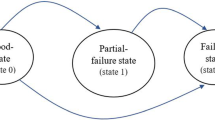Abstract
This paper deals with imperfect preventive maintenance optimization problem. The system to be maintained is assumed to be subject to random deterioration. To reduce the risk of failures, the proposed maintenance model takes into account two type of maintenance actions, namely corrective maintenance (CM) and preventive maintenance (PM). The system undergoes PM whenever its reliability reaches an appropriate value, while CM is performed at system failure. After a given number of maintenance actions, the system is preventively replaced by a new one. Both CM as well as PM are considered imperfect, i.e. they bring the system to an operating state which lies between two extreme states, namely the as bad as old state and as good as new state. The imperfect effect of CM and PM is modeled on the basis of the hybrid hazard rate model. The objective of the proposed imperfect PM optimization model consists on finding the optimal reliability threshold together with the optimal number of PM actions to minimize the expected total maintenance and replacement cost per unit of time. A mathematical model is then proposed. To solve this problem an algorithm is provided. A numerical example is also given to illustrate the proposed maintenance model.




Similar content being viewed by others
References
Barlow, R., Proschan, F. (1996). Mathematical thoery of reliability. Reprint (31 Dec) edn, Society for industrial and applied mathematics, US.
Barlow, R., & Hunter, L. (1960). Optimum preventive maintenance policies. Operations Research, 8(1), 90–100.
Berenguer, C., Chu, C., & Grall, A. (1997). Inspection and maintenance planning: an application of semi-markov decision processes. Journal of Intelligent Manufacturing, 8, 467–476.
Cho, D. I., & Parlar, M. (1991). A survey of maintenance models for multi-unit systems. European Journal of Operational Research, 51, 1–23.
Chouikhi, H., Khatab, A., & Rezg, N. (2012). A condition based maintenance policy for a production system under excessive environmental degradation. Journal of Intelligent Manufacturing. doi:10.1007/s10845-012-0715-9.
Dekker, R. (1996). Application of maintenance optimization models: a review and analysis. Reliability Engineering and System Safety, 51(3), 229–240.
El-Ferik, S., & Ben-Daya, M. (2006). Age-based hybrid model for imperfect preventive maintenance. IIE Transactions, 38, 365–375.
Ghasemi, A., Yacout, S., & Ouali, M. (2007). Optimal condition based maintenance with imperfect information and the proportional hazards model. International Journal of Production Research, 45(4), 989–1012.
Jardine, A., & Tsang, A. (2006). Maintenance, replacement and reliability, theory and applications. London: Taylor and Francis.
Khatab, A., Rezg, N., & Ait-Kadi, D. (2011). Optimum block replacement policy over a random time horizon. Journal of Intelligent Manufacturing, 22(6), 885–889.
Liao, W., Pan, E., & Xi, L. (2010). Preventive maintenance scheduling for repairable system with deterioration. Journal of Intelligent Manufacturing, 21(6), 875–884.
Lin, D., Zuo, M. J., & Yam, R. C. M. (2000). General sequential imperfect preventive maintenance models. International Journal of Reliability, Quality and Safety Engineering, 7(3), 253–266.
Lin, D., Zuo, M. J., & Yam, R. C. M. (2001). Sequential imperfect preventive maintenance models with two categories of failures modes. Naval Research Logistics, 48(2), 172–183.
Lugtighei, D., Jardine, A., & Jiang, X. (2007). Optimizing the performance of a repairable system under a maintenance and repair contract. Quality and Reliability Engineering International, 23, 943–960.
Malik, M. (1979). Reliable preventive maintenance scheduling. AIIE Transactions, 11(3), 221–228.
Nakagawa, T. (1988). Sequential imperfect preventive maintenance policies. IEEE Transactions on Reliability, R–37(3), 295–298.
Nakagawa, T. (2008). Advanced reliability models and maintenance policies. Berlin: Springer.
Nakagawa, T., & Mizutani, S. (2009). A summary of maintenance policies for a finite interval. Reliability Engineering and System Safety, 94(1), 89–96.
Nguyen, D. G., & Murthy, D. N. P. (1981). Optimal preventive maintenance policies for repairable systems. Operations Research, 29, 1181–1194.
Pham, H., & Wang, W. (1996). Imperfect maintenance. European Journal of Operational Research, 94, 425–438.
Schutz, J., Rezg, N., & Leger, J.-B. (2011). Periodic and sequential preventive maintenance policies over a finite planning horizon with a dynamic failure law. Journal of Intelligent Manufacturing, 22(4), 523–532.
Sheu, D. D., & Kuo, J. Y. (2006). A model for preventive maintenance operations and forcasting. Journal of Intelligent Manufacturing, 17(4), 441–451.
Sun, Y., Ma, L., & Morris, J. (2009). A practical approach for reliability prediction of pipeline systems. Transactions of the ASME, 198, 210–214.
Tian, Z., & Liao, H. (2011). Condition based maintenance optimization for multi component systems using proportional hazards model. Reliability Engineering and System Safety, 96, 581–589.
Won, Y., & Chung, H. (2000). Optimum replacement intervals with random time horizon. Journal of Quality in Maintenance Engineering, 6(4), 269–274.
Xia, T., Xi, L., Zhou, X., & Du, S. (2012). Modeling and optimizing maintenance schedule for energy systems subject to degradation. Computers and Industrial Engineering. doi:10.1016/j.cie.2012.01.014.
Yang, Z. M., Djurdjanovic, D., & Ni, J. (2008). Maintenance scheduling in manufacturing systems based on predicted machine degradation. Journal of Intelligent Manufacturing, 19(1), 87–98.
Zhao, Y., Volovoi, V., Waters, M., & Mavris, D. (2006). A sequential approach for gas turbine power plant preventive maintenance scheduling. Transactions of the ASME, 128, 796–805.
Zhou, X., Xi, L., & Lee, J. (2007). Reliability-centered predictive maintenance scheduling for continuously monitored system subject to degradation. Reliability Engineering and System Safety, 92(4), 530–534.
Author information
Authors and Affiliations
Corresponding author
Rights and permissions
About this article
Cite this article
Khatab, A. Hybrid hazard rate model for imperfect preventive maintenance of systems subject to random deterioration. J Intell Manuf 26, 601–608 (2015). https://doi.org/10.1007/s10845-013-0819-x
Received:
Accepted:
Published:
Issue Date:
DOI: https://doi.org/10.1007/s10845-013-0819-x




